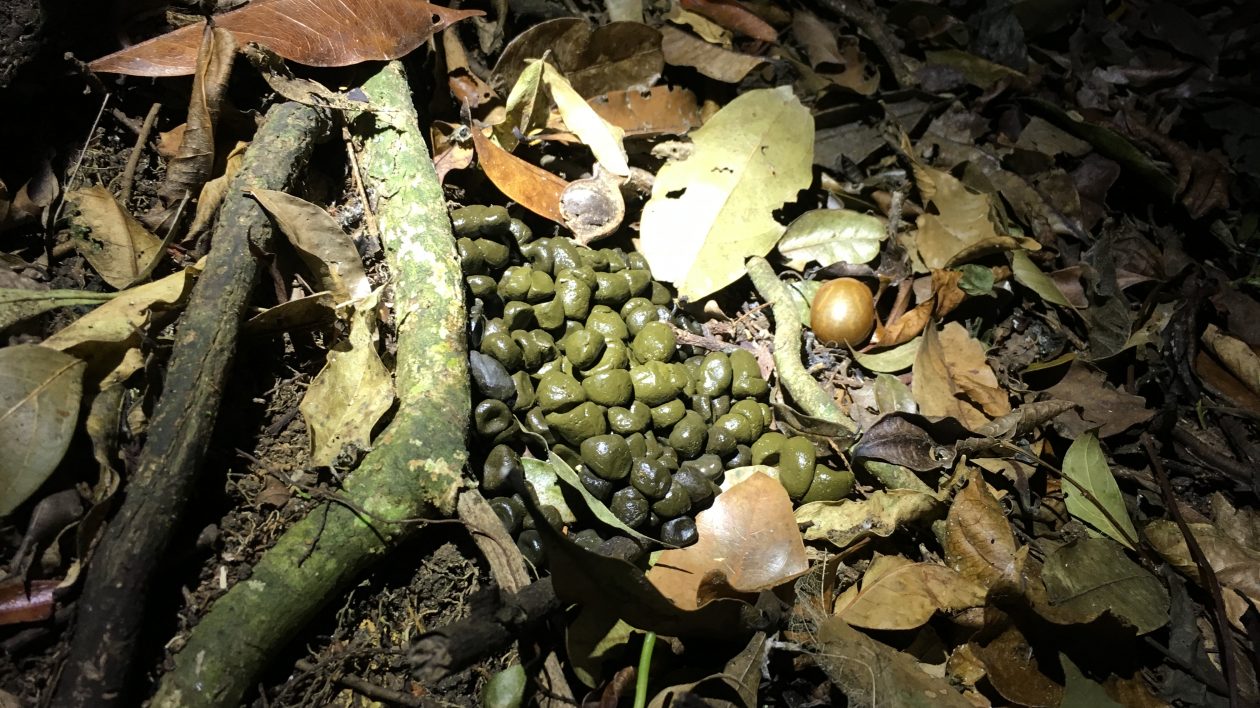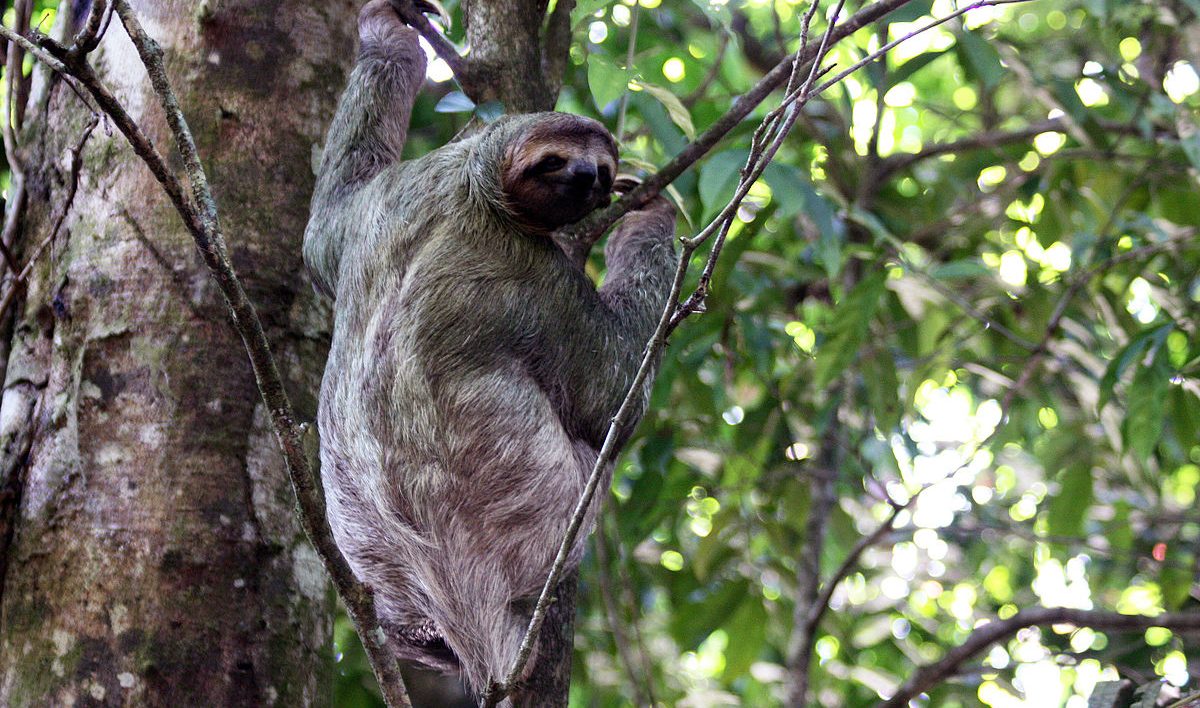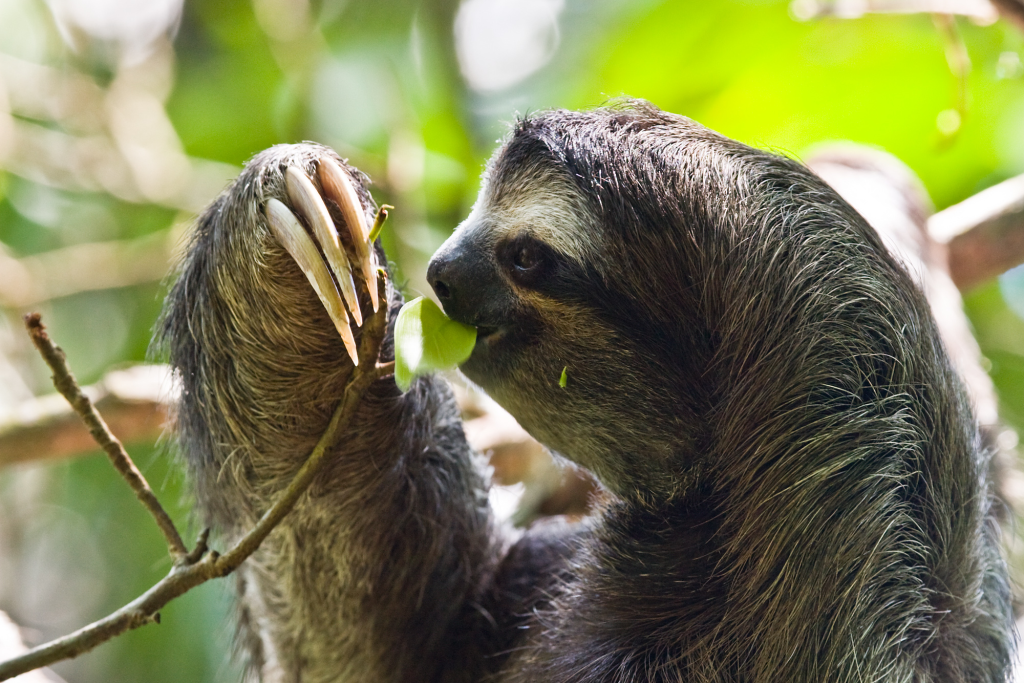The sluggish creature crept along a tangle of vines towards us. I watched, half-listening to our night walk guide as he identified the grey furry shape as a brown-throated three-toed sloth. The rest of the group giggled at its slow, clumsy movements, but I knew that for a sloth this was practically a flat-out Olympic sprint. And with each clambering movement it was coming closer and closer to us. And to the ground.
“I think it’s coming down!” our guide said, his voice growing more and more excited.
“Oh my god…” I whispered, half-strangled with disbelief. Our guide looked at me, and we realized that we were thinking the exact same thing.
“Do you think it’s going to… ?”
“But it’s so rare, what are the odds that we would… Oh my god.”
By this point the sloth was just a few meters away, likely breaking some sort of sloth record for fastest descent. There was absolutely no mistaking what was about to happen.
This sloth was about to poop. And we were going to watch.
When Defecation Is Deadly
The brown-throated sloth (Bradypus variegatus) is one of two sloth species found in Costa Rica. They live mostly solitary lives high in the forest canopy, with small home ranges of about 5.5 hectares, or a little more than 5 soccer fields.
Adorable as they are, you might think twice about wanting to snuggle a sloth. All three-toed sloths have unique hair with cracks along the surface that absorb water to nourish colonies of hydroponic algae. These fur gardens — which often give the sloth’s fur a greenish tinge — also house multiple species of arthropods and fungi.
Despite what we humans would consider highly questionable personal hygiene habits, sloths are incredibly fussy poopers. Hanging upside down isn’t necessarily the best angle from which to enjoy the Sunday paper in privacy, if you know what I mean. So every time a three-toed sloth needs to defecate it makes the slow, arduous journey down from the canopy and onto the forest floor, where it poops below the same tree every time.
Scientists aren’t exactly sure why three-toed sloths stick to the same tree, but it’s possible that they use these latrines to communicate with other sloths, avoid detection from predators, or even as a means of fertilizing their favorite trees.

Three-toed sloths cut down on the inconvenience by only pooping an average of once every week, a frequency that would have most of us downing laxatives and praying for death. Infrequent pooping is normal for sloths, which eat toxic leaves from just a few species of trees and have the slowest rate of digestion of any mammal species. We were patrolling a tiny patch of cloud forest for just two hours on one night, so to stumble on a sloth making its pre-potty descent was preposterously lucky.
Infrequent bowel movements are also a built-in safety feature. Sloths are an easy fast-food meal (pun intended) for numerous predators, but they’re much safer when camouflaged in the canopy. It’s a different story on the ground, where research shows an estimated 50 percent of sloths meet an untimely end. It’s bad enough to have a jaguar pounce on you, but it’s even worse when they pounce mid potty break.
Traveling down from the canopy also burns a lot of energy for slow-moving sloths, and scientists estimate that each trip costs a sloth about 8 percent of its daily energy needs.
The tradeoff for this infrequent schedule is that by the time a sloth is ready to go, they have quite a backlog of, ahem, inventory waiting to move. Scientists estimate that with each dump, sloths lose about one-fifth of their body weight. ONE-FIFTH. That’s the equivalent of a 150-pound person leaving a 30-pound poop.
Caught in the Act
By this point the rest of the group had figured out that we were about to see something special, even if they weren’t exactly sure why I was literally jumping up and down. We stood quietly as the sloth swung down the last few feet of vine, descending head first before plopping awkwardly onto the forest floor.
It righted itself, sitting on the ground and grasping the vine with each of its front claws. Then it began to wiggle, rustling its posterior around in the leaf litter in front of an audience of 30 tourists trying desperately (and unsuccessfully) not to giggle.
After a few seconds our guide very thoughtfully turned off his spotlight to allow the poor creature a shred of privacy. There was a full moon, so we still had a pretty decent view of the continued wiggling and straining. After about 10 seconds of this bottom boogie the sloth heaved itself upward and began slow-motion racing back up the vine, without a backward glance.
The spotlight clicked back on, and we saw the little grey sloth bum receding back up to the treetops. Our guide looked at me, grinning, and said “Go for it.” I shot off towards the poo pile, camera in hand, as he filled the rest of the group in on what we had just seen.
Nestled amidst the leaves was a pile of little brown nuggets, each the size of a cherry tomato. Given the size of the deposit I suspected that our little friend hadn’t quite fulfilled his mission, and with an audience of 30 people I don’t blame him.

Moths, Sloths and Symbiosis
After taking a few pictures of the sloth poo, I grabbed a stick and began prodding the pile in search of moths. Yes, moths.
When a sloth descends to earth to poo, female pyralid moths crawl out of the sloth’s fur and lay their eggs in the poo pile. The moth larvae feed on the decaying sloth excrement, and once they develop into adults they fly back into the canopy in search of a new sloth to live on.
Clearly the moths have got it made, but do the sloths benefit from this relationship? To get to the bottom of the mystery (pun intended), American scientists captured sloths from two different species in Costa Rica. The brown-throated three-toed sloth, like the one I had just seen do the deed, always poops on the ground. But the Hoffman’s two-toed sloth isn’t as picky and will also poop from the canopy. (Heads up!)
The scientists used a small vacuum to suck up all of the moths they could find on each sloth. They also took hair samples to see if there were differences in the fur microbiota and chemical makeup between species.
They discovered that three-toed sloths have more moths, and that more moths corresponds to higher levels of nitrogen and algae in the fur. The researchers think that the moths are somehow increasing nitrogen levels, which acts as a fertilizer for the algae.

So what’s the benefit for the sloths? We’re still not sure.
The researchers theorized that the algae might provide a mobile source of additional nutrition for the sloths. But until someone documents widespread self-licking amid the sloths, it’s not clear how extra nutrients in the fur would make their way into the sloth’s diet. What is clear, though, is that the moths alter the furry biome of their mobile sloth homes.
Unfortunately, no moths emerged from the still-glistening pile of sloth poo, despite my thorough prodding. The beleaguered sloth was back in the canopy, and it was time to move on to see what other wildlife we could find in the forest this night.
But one thing was for sure: I was never going to look at a sloth the same way again.




Informative and very enjoyable to read, thank you for writing!
I want to thank you for the explanation of what the difference is between Sloths. Very educational to say the least! I never heard of a Sloth before in my life! I was watching a Youtube video & under the video, someone posted something about a Sloth climbing up a tree captured in the background of a video.
I had to research about Sloths, & what exactly are they!? Which brought me to this story along with pictures of what a Sloth looks like & much more than I bargained for, researching about Sloths.
Very interesting little creature I have to say, very cute little mammal as well! 🙂
Glad this interesting animal have safe places to live and not be disturbed.
When I was in my early 20s (I’m now 70 years old), I was an animal behavior grad student at the University of Maryland and I was fortunate to visit “Barro Colorado Island,” which is located in Gatun Lake, in the middle of the Panama Canal. The island, which is part of the Smithsonian Tropical Research Institute, is a famous spot for lowland tropical forest research.
There I spent a week helping Mel Sunquist and Gene Montgomery radio-track three-toed sloths. Those guys (the researchers) were amazing … they would climb well over a hundred feet into the canopy to noose sloths with the help of a long, extendable pole. Then they’d place the sloth in a bag, lower it to the ground, glue a radio-tracking unit on its back, and finally release it on the trunk of the capture-tree.
While I never actually witnessed a sloth doing its poop-thing, I sure heard plenty about it. How they slowly descend, put their rears to the ground, and then rotate their stubby tail this direction and that in order to create a depression in which to poop. The general feeling at the time was that they are fertilizing favorite feeding trees, but who knows? It seems doubtful that it’s a form of territorial marking, simply because sloths don’t patrol territories on the ground.
Whatever the actual explanation, sloths provide one of the best poop-stories in the world of animal behavior … excepting of course the hippos, which indiscriminately fling their poop in all directions. In the sloth world, that would be madness indeed!
Love the article. It was very informative. Thank you
Dear Justine,
That’s a wonderful story, thank you for sharing!
I didn’t know about the moth/sloth relationship – fascinating.
You might enjoy this video, too. It’s a personal favourite in the Three-toed Sloth Category of short films.
Enjoy! http://www.youtube.com/watch?v=ba7rRfKIHxU
Kate.
Dear Justine,
Great story. It should be published besideArchie Carr’s account of sloths mating in “The Windward Road.”
Thanks,
Bob Burns